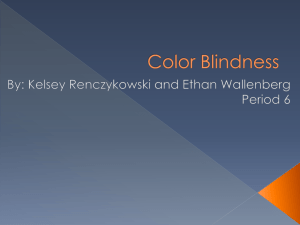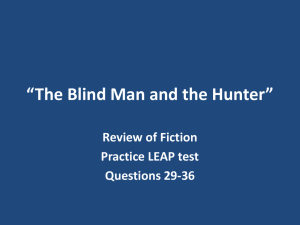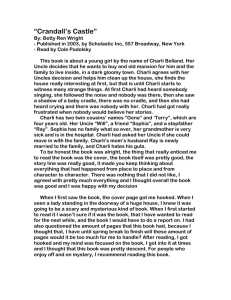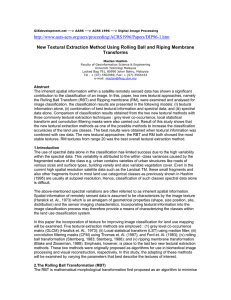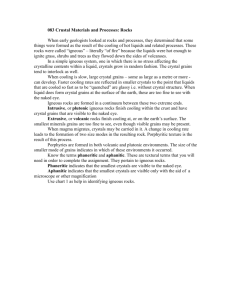Task.MP3 Storybooks for the Blind 2 - Pay-it-Forward-for
advertisement
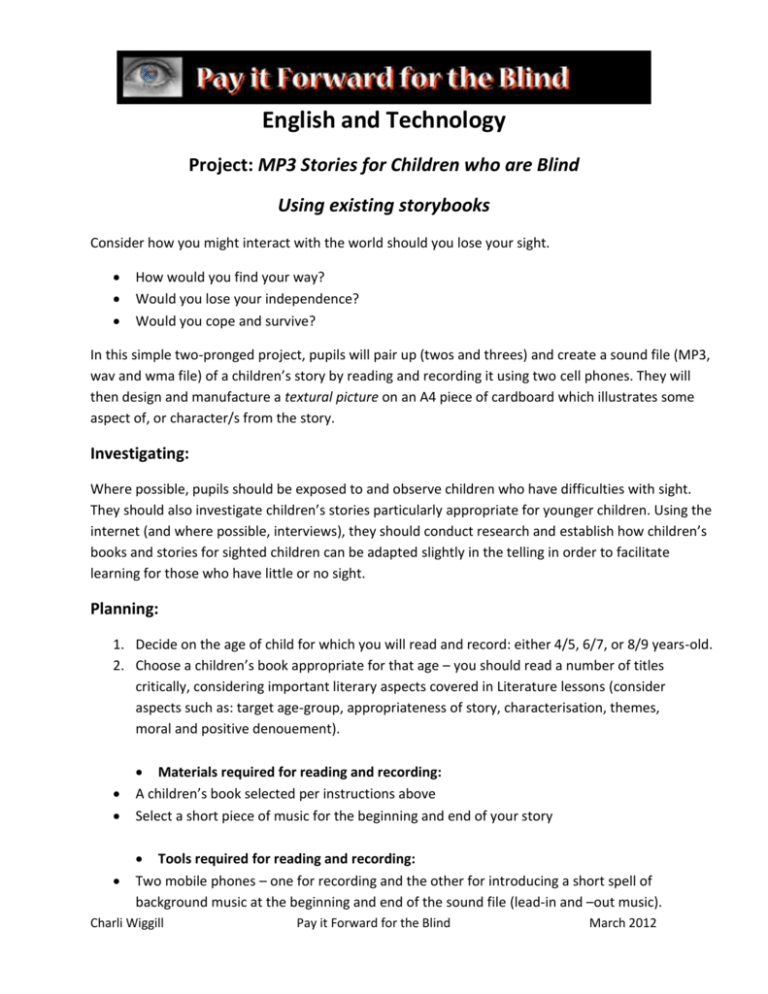
English and Technology Project: MP3 Stories for Children who are Blind Using existing storybooks Consider how you might interact with the world should you lose your sight. How would you find your way? Would you lose your independence? Would you cope and survive? In this simple two-pronged project, pupils will pair up (twos and threes) and create a sound file (MP3, wav and wma file) of a children’s story by reading and recording it using two cell phones. They will then design and manufacture a textural picture on an A4 piece of cardboard which illustrates some aspect of, or character/s from the story. Investigating: Where possible, pupils should be exposed to and observe children who have difficulties with sight. They should also investigate children’s stories particularly appropriate for younger children. Using the internet (and where possible, interviews), they should conduct research and establish how children’s books and stories for sighted children can be adapted slightly in the telling in order to facilitate learning for those who have little or no sight. Planning: 1. Decide on the age of child for which you will read and record: either 4/5, 6/7, or 8/9 years-old. 2. Choose a children’s book appropriate for that age – you should read a number of titles critically, considering important literary aspects covered in Literature lessons (consider aspects such as: target age-group, appropriateness of story, characterisation, themes, moral and positive denouement). Materials required for reading and recording: A children’s book selected per instructions above Select a short piece of music for the beginning and end of your story Tools required for reading and recording: Two mobile phones – one for recording and the other for introducing a short spell of background music at the beginning and end of the sound file (lead-in and –out music). Charli Wiggill Pay it Forward for the Blind March 2012 You may also wish to add sound effects to the backing track where appropriate. These could enhance your story substantially. Materials required for the textural picture: Cardboard (A4) Various scrapbooking-type materials, sandpaper, fabric and so on Glue Tools required for the textural picture: Scissors Glue-gun (optional) Copyright issues: 1. You need to email or write to the author and/or publisher of the book you intend reading and ask for permission to record it and then upload it to the website for the blind. You should be able to find an email address or website inside the book. If there is none available, then search on the internet for the author’s name or publishing house. Rewriting the story: 1. As discussed in class, children’s storybooks contain as much as 70% of the information as visual clues in the pictures – therefore blind children may miss out on important content when merely listening to the story. 2. Your group needs to critically analyse the text versus the visual content and decide what additions need to be made to the storyline to enhance the meaning for the blind. 3. Once the decisions are made, you will need to rewrite the story with the additions, maintaining the style and fluidity that the original author intended. 4. Once you have a final draft with which your whole group is happy, you should use that as your script for your recording. Recording: 1. Record the story on your cell phone whilst reading from the book. 2. The partner plays the music at start and end of the story, fading music in and out. 3. Sound effects can be added later on using the second phone or when in the editing mode 4. Save sound file as MP3, wav and wma file and email to charliwiggill@gmail.com Designing the textural picture: 1. Using Adobe Photoshop, create a new file. 2. Pre-set size of canvas as A4 and Resolution as 300 pixels per inch Charli Wiggill Pay it Forward for the Blind March 2012 3. Either use the ‘Place’ option to insert the picture you wish to illustrate, or use the drawing tools to create your original image 4. Once satisfied with the placement and relative sizes of the elements, flatten the layers 5. Save your file to the appropriate folder 6. Print out a copy as your pattern Making the textural picture: 1. Using a piece of cardboard (A4), copy or print the pattern you created in Photoshop 2. Transfer the simple picture from your Photoshop pattern to the thick card 3. Cut up the printed picture into the various elements, so turning it into pattern pieces (e.g. roof, door, windows and so on) 4. Use the pattern pieces to cut the different textured materials for the various elements in your picture, cut according to size and shape and glue these into place. The picture should be large enough for children to differentiate between the different parts of the picture using touch only. Evaluating: 1. Pupils should listen to the story and decide whether it should be re-recorded (use the ‘Recording Quality Control’ form for peer-group- and your own group-assessment.) 2. Pupils should cover their eyes and then ‘test’ a few textural pictures that groups of their peers have made using ONLY their fingers to ‘read’ and ‘see’ the pictures. Global partnerships: Enter the world of international collaboration by contacting Mr Charli Wiggill charliw@telkomsa.net for further information. It would be wonderful to email sound files around the world to be offered to schools with children who are blind as well as pre-schools with sighted children. Any ideas to extend this project will be considered and will be greatly appreciated. Charli Wiggill Pay it Forward for the Blind March 2012


